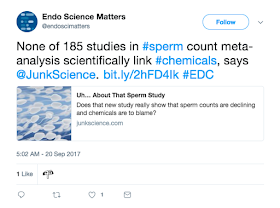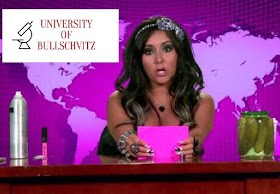They open the documentary with a quote from Gwyneth Paltrow - who has now joined Vani Hari as a Skeptic community soft target du jour.
 |
| Science Moms director Natalie promotes the film on Twitter. |
The first segment introduces us to the Science Moms and gives them a moment to tell the audience what led them to their respective role in this group. Three of the five Moms featured have science degrees. Anastasia Bodnar is a plant geneticist and describes herself as an 'ecomodernist'. Layla Katiraee is a GMO Answers contributor, has a Ph.D. in molecular genetics and works for a biotech company. Alison Bernstein aka Mommy Phd is a neuroscientist who describes herself as "committed to promoting science and destroying pseudoscientific claims" on her Twitter profile.
Kavin Senapathy, is referred to in the film as a 'science communicator'. She is a co-founder of March Against Myths (MAMyths) and an author of The Fear Babe: Shattering Vani Hari's Glass House. She is also employed by a company founded by her father called Genome International specializing in bioinformatic technologies.
Jenny Splitter's backstory is definitely the most enthralling of the five. She is described by the filmmakers as a science communicator and story teller. "I didn't have any interest in science until probably a couple years ago, just, you know, getting involved in the Skeptical movement as a parent. But I was not doing science experiments in my garage or anything like that,"she states at the beginning of the documentary.
 |
| This can't even is brought to you by Kavin. |
For all its production value - it is well filmed and edited, and nicely scored - the content is what I have come to expect from Skeptics. There was nothing in this film I hadn't heard before, there are no new revelations or profound ideas to mull over. They mention the hard hitting issue of vagina steaming, homeopathy, and 'fear based marketing' along with some of the common misleading catch phrases employed by Skeptics - 'everything is made of chemicals', 'all our food is genetically modified'. Senapathy, the co founder of MAMyths, ironically enough repeats a common myth about the holy grail of genetic engineering, golden rice. "Because of anti-GMO ideology and lobbying and over regulation, this rice has not reached the people who need it. Tragic!"
While some of the points made by the Moms have merit, like criticism of marketing techniques for instance, they feel misplaced. Organic food becomes the fall guy here, but what about junk food advertising to our kids? Have they never been in a cereal aisle? Rising autism rates are brushed off as just 'better diagnosis' and the dumbfounding claim that "30 years ago, a diagnosis didn't even exist" is made. Leo Kanner aside, thirty years ago was when the movie Rain Man was made. Did they miss it? Cancer statistics are badly misrepresented as people simply 'living longer' and they fail to mention declining fertility, increases in autoimmune diseases, celiac, obesity, diabetes and other chronic conditions. They present things like choosing organic or avoiding BPA as 'fear based' parenting.
All in all the Science Moms present a rosy view of the future, where technology in all its forms and uses can and should be embraced unequivocally simply because it's 'science'.
Life, and especially parenting really does get overwhelming at times and so I can see the appeal in this hakuna matata attitude towards food, medicine, and chemical exposures. But in reality these topics are so much more nuanced that it couldn't begin to be covered appropriately in a 30 minute documentary film. For all their talk about evidence, the Science Moms don't actually provide anything to back their claims made in the film, and upon my investigation many of their stated opinions turn out to be false, cherry picked or even just logically fallacious, as one of the Moms states in the film, "Personal research is not science!"
 |
| Mind blown. |
I believe that these women came together for the reason they state - because Buffy the Vampire Slayer and other celebrities supported labeling of genetically engineered foods. I do not think that this film or this group was created by Monsanto or any other company as has been suggested by some, but between what I have observed and what they themselves state, I cannot feel confident that their message is fully independent of some level of industry influence. I also feel like Moms 4 GMOs would have been a more accurate title for the film and the group, seeing that this technology is their main focus.
It's no secret that the Skeptic movement is targeted by industry public relations people. Some of the Science Moms themselves have what can be considered a conflict of interest (COI) as they work in the biotech industry and therefore their message may be influenced by their source of income. One of the Science Moms, Layla Katiraee is listed as an expert on the Ketchum PR biotech funded website GMO Answers - as is one of the producers, Mary Mertz. In fact, amongst the list of producers we have quite a diverse array of people, many with connections to the biotech, agriculture and food industries.
 |
| Frieda A. Custodio, a nutrition researcher based in St. Louis, MO shares the producer credits on Instagram. |
Peggy Greenway is a pork producer, Bill Price is Director of Statistical Programs in the College of Agriculture at the University of Idaho, Kim Bremmer founder of AgInspirations, Joan Conrow from the Cornell Alliance for Science and Montserrat Benitez, currently with Syngenta, formerly with Monsanto and PepsiCo. Cami Ryan, Social Scientist for Monsanto Company is listed as a one of the many Kickstarter donors and unsurprisingly, Vance Crowe is amongst the names receiving special thanks at the end of the film. The director Natalie Newell counts him amongst her friends.
Of course this makes people wonder about the level of influence these friends have, and I think it's fair to question whether the opinions expressed in the film are truly impartial.
 |
| Choosy moms choose Jif! |
All in all, the Science Moms documentary is on par with the type of content being disseminated by most Skeptics. I don't see this as being a vehicle to enhance further discussion of parenting topics, science or technology. It's not a film that goes beyond pushing conclusions and facts to its audience, and does little to promote science literacy or critical thinking.
A wise man once said - "I am not impressed by the correctness of your regurgitations, rather the insight and power of your ideas."










































